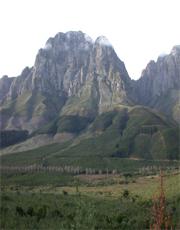 These pine plantations in South Africa were shown to dry up local streams.© Science
These pine plantations in South Africa were shown to dry up local streams.© SciencePlanting forests to soak up carbon dioxide from the atmosphere can have a range of side effects, including drying up streams and making soil saltier, according to a global study. The discovery highlights the tradeoffs involved in tree-planting projects, say researchers.
Because plants use carbon dioxide to grow, planting forests of large, fast-growing trees is one way to remove the gas from the atmosphere, thus staving off global warming. But such forests need a lot of water, say Robert Jackson, of Duke University in Durham, North Carolina, and his colleagues.
The team surveyed more than 500 places where new forests have been planted over the past half-century. In 13% of cases, streams dried up completely for at least a year. On average, plantations cut local stream flow by more than 50%.
"It doesn't matter where you are in the world, when you grow trees on croplands, you use more water," Jackson says. The effect can reduce the water available for drinking and irrigation, and harm local aquatic ecosystems.
And forest soils are saltier and more acidic, compared with other types of plant cover such as crops or grasslands, the researchers found. They publish their results in this week's issue of Science1.
Carbon trading
These changes occur partly because tree-planting projects choose fast-growing species that suck up more carbon dioxide, Jackson explains. Often these are evergreen trees that grow all year round, meaning that they take up a lot of carbon dioxide and water.
Some changes to water flow may be desirable, the team points out. For example, forest plantations in the US agricultural belt have reduced nutrient runoff from farmlands into the sea, which can cause algal blooms that kill marine life.
ADVERTISEMENT
The key is to consider local factors when implementing afforestation projects, the researchers argue. "Policy-makers often have a set of 'carbon blinders' on - they're thinking and talking only about carbon," Jackson says.
Some nations and companies are currently planting forests as a way of earning 'carbon credits' in international carbon markets. These allow greenhouse-gas emitters such as power companies to balance their emissions by buying carbon savings elsewhere.
The Clean Development Mechanism, the United Nations framework that approves and validates such efforts for projects under the Kyoto Protocol, has also approved the method of reforesting degraded land to suck up carbon. No forest-planting project has so far been registered by this mechanism, but Jackson says afforestation projects could be accredited soon. He only hopes that all the costs - including the effect on water - are being taken into account, he says.
